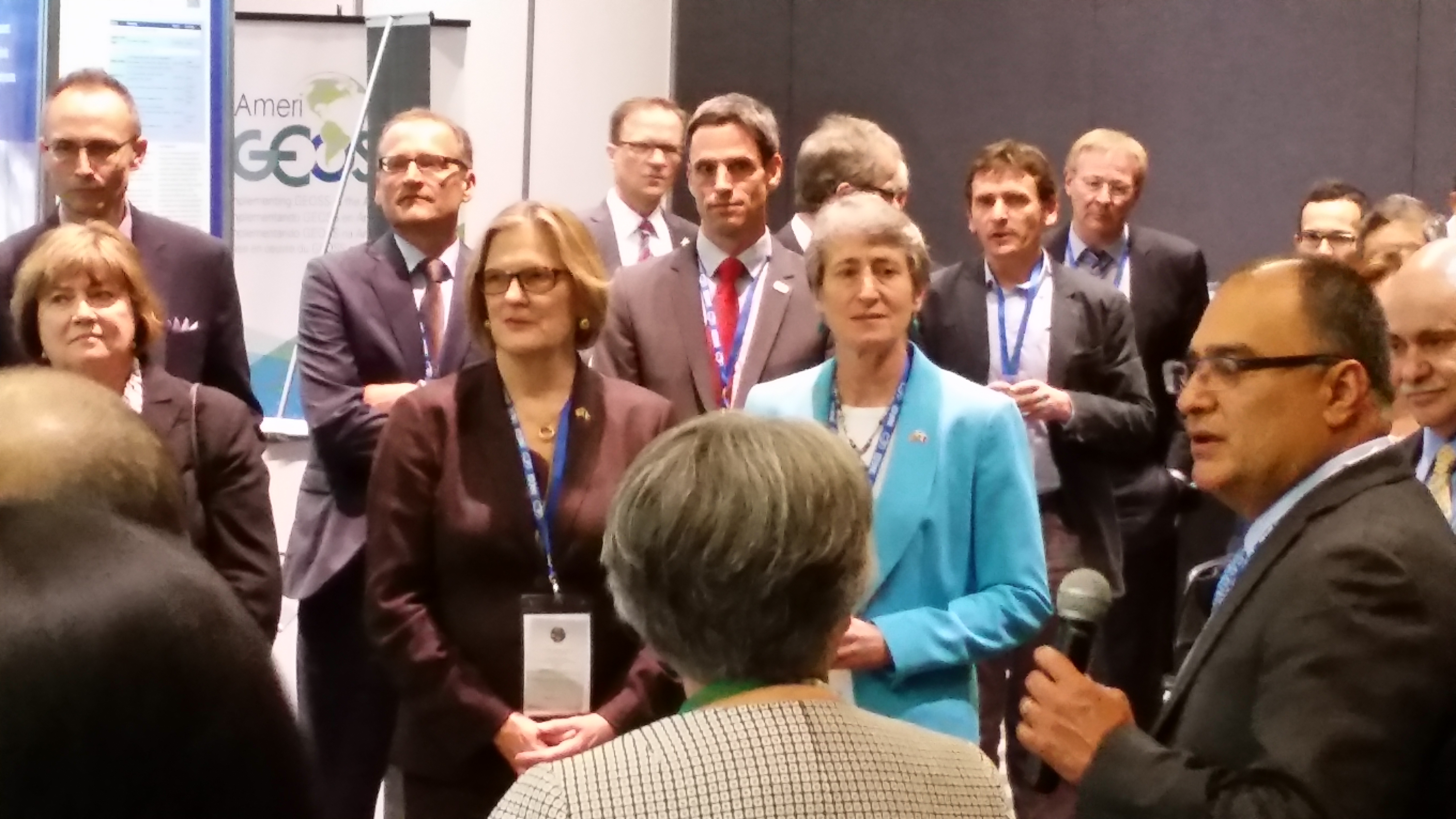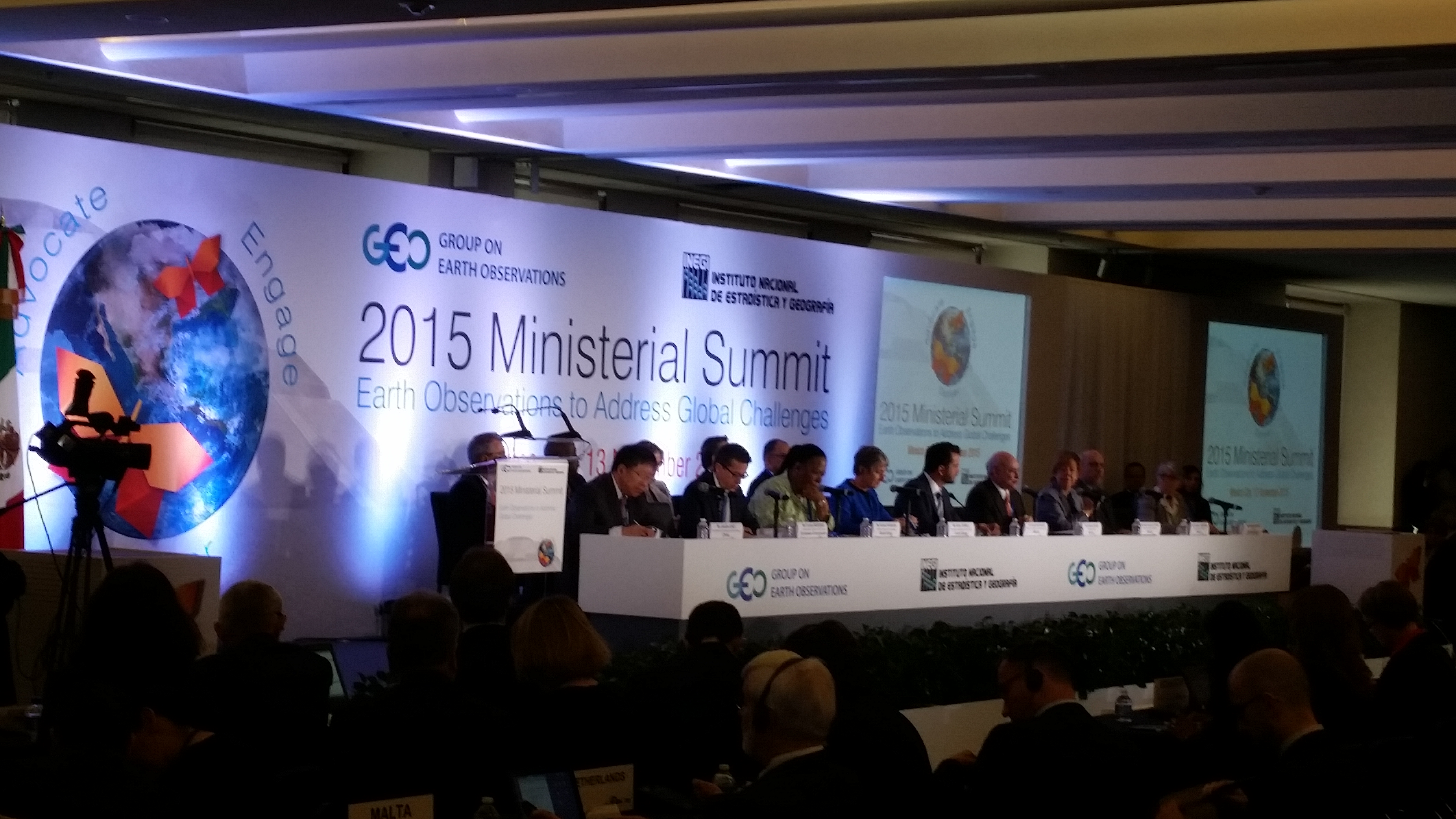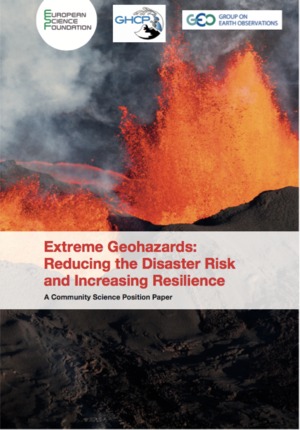News
[February 10, 2017] How to be successful under unfavorable conditions?: In a new column in ApogeoSpatial, Hans-Peter Plag finds that the Sustainable Development Goals (SDGs) of the 2030 Agenda of the United Nations came in a world not prepared for them and he addresses the question how they can be successful under these umfavorable conditions.
[February 1, 2017] Science March on D.C.: In response to recent developments, which are considered to be threatening for science and the role of knowledge in society, a group of scientists is planning a Science March on Washington, D.C. The likely date for the March is April 22, 2017. More information is available on the Science March Page.
[January 31, 2017] ConnectinGEO Project is ending: The ConnectinGEO project is ending. Deliverables include an extensive study on methodologies to capture user needs and to identify and prioritize gaps. See the WP 2 and WP 6 pages for details.
[December 10, 2016] Workshop on SGD Platform: Tiwah supported the organization of the 5th GEOSS Science and Technology Stakeholder Workshop on “Linking the Sustainable Development Goals to Earth Observations, Models and Capacity Building,” which took place at the University of California, Berkeley, Ca, USA, on December 9-10, 2016. See the web page for more information.
[October 8, 2016] Support for SGD Implementation: In an article in ApogeoSpatial, Shelley Jules-Plag and Hans-Peter Plag show that agend-based models and GeoDesign can support the development of policies that foster progress towards the SDGs. The article is available as pdf.
[August 16, 2016] EO and Model Support for SGDs: In an article in the Geospatial World Magazine, Shelley Jules-Plag and Hans-Peter Plag make the case that Earth observations and models are important in supporting policy development for the implementation of the SDGs and for the monitoring of progress towards the associated targets.
[May 3, 2016] “More processes that can accelerate Greenland ice melt”: Several studies discussed in the Washington Post (see the arcticle by Chelsea Harvey) show that the disappearance of Arctic sea ice is accelerating ice melt. A study emphasizes a increasing in the blocking effect as a major contribution.
[December 5, 2015] Safeguarding our Life Support System: In a new < href="http://apogeospatial.com/safeguarding-our-life-support-system/">article in the column “On the Edge” in ApoGEO Spatial, Hans-Peter Plag emphasizes the need to safeguard the Earth's life suport system, on which we and future generations depend. In order to do so, we need to overcome the “immutable truth” that growth is neccesary for a trhiving economy.
[December 1, 2015] The Climate Pledges at COP 21 are Progress, but far from being enough: In an article in the Washington Post, Chris Mooney summarizes comments scientists provided on the climate pledges of many nations made at COP21 in Paris. The scientists he refers to are concerned that the pledges are far from enough to avoid an ice-free planet, which would lead to a large sea level rise with devastating consequences for future generations and severe impacts already over the next few decades. The science he nrefers to is documented in a report prepared by the International Cryosphere Climate Initiative.
[November 25, 2015] The risk of investing in fossil fuels: An article in The Guardian stipulates that a potential climate deal during COP21 could render oil, gas and coal projects worthless and cause the loss of $2 trillions of inverstors' money, primarily in the U.S., Canada, China, and Australia. The article is based on a Report of the Carbon Tracker Initiative. See also the video sumarizing the findings.
[November 24, 2015] 90% of disaster in the last 20 years are weather related: A new report published by UNISDR finds that most recent disasters are related to extreme wetaher events.
[November 24, 2015] New study finds there is no evidence for a global wwarming pause: A study by Levandowsky et al. published in Nature using a NASA dataset finds no evidence for a “pause” in the trend of global warming. The oscillations around the very pronounced warming trend are due to interannual to decadal variations but do not reduce the overall trend of rapid warming. See also the article by Chris Mooney in The Washington Post.
References: Lewandowsky, S., Risbey, J. S., Oreskes, N., 2015. On the definition and identifiability of the alleged “hiatus” in global warming. Nature Scientific Reports, 5, Article number: 16784 (2015), doi:10.1038/srep16784.
[November 19, 2015] A Report Card for States At Risk: As a result of the “first-ever national analysis of state-level preparedness for climate-driven threats, ” the web page “States at Risk: America's Preparedness Report Card&dquo; is available. It “is the first-ever quantitative assessment that summarizes the changing nature of key threats, including extreme heat, drought, wildfires, inland flooding, and coastal flooding, and the corresponding levels of preparedness in each of the 50 states. The goal of the Report Card is to help states improve their level of preparedness by recognizing risks from the climate-related threats they face, building an action plan, and implementing this plan.” Visit the Reporting Card at stateatrisk.org ...
[November 16, 2015] Another Greenland glacier enters a rapid melting process: The Zachariae glacier in northeastern Greenland is the latest glacier which started a rapid melting process due to contact with warm ocean water. This process could result in 0.5 m of sea level rise. Read more in the Washington Post article by Chris Mooney ...
[November 10, 2015] The urgent need for climate action: Lord Stern, a leading climate change expert in the U.K., urged Europe to step up its effort to combat climate change and wake up to the urgency of the situation. Before the UN talks in Paris later this month he said that, “In human history it’s a one-off ... and what we map out in the next two decades will be absolutely critical. Whether we can live in our cities — breathe in them, move in them — all of this will be defined by the decisions we take” Read the Guardian article by Juliette Jowit ...
[November 09, 2015] Climate change could increase poverty: A World Bank report finds that climate change could push 100 million into poverty by 2030, as reported in The Guardian and Scientific American. This could counteract the efforts related to the Sustainable Development Goal (SDG) 1: “End poverty in all its forms everywhere.”
[October 28, 2015] The Greenland ice sheet is melting away: The New York Times reports in an amazingly illustrated article about the accelerated melting of the Greenland ice sheet and emphasizes the consequences for sea level rise. Read the article by Coral Davenport, Josh Haner, Larry Buchanan and Derek Watkins ...
[October 27, 2015] Climate Commitments are insufficient and dangerous: A study by the European Commission Joint Research Centre comes to the conclusion that the current climate commitments by 155 countries will lead to a global warming of 3oC, which would be highly dangerous for humanity. Read the press release ...
[October 26, 2015] A big and bad climate story is unfolding in Indonesia: The forest clearing by fire and the peatland fires resulting from draining these areas cause “emissions so voluminous that on several days this year they have surpassed the daily emissions output of the entire U.S. economy.” Read the article by Juliet Eilperin and Chris Mooney ...
[October 10, 2015] Stuff happens, for example climate change: In a recent opinion editorial in the New York, Thomas Friedman points out that we have reached a tipping point in terms of reacting to the climate change threat — “except for some of the knuckleheads running to be our next president, which is not a small problem.” He makes reference to the new book ”Big World, Small Planet” by Johan Rockstrom and Mattias Klum, which emphasizes the exceptional stability of the Holocene providing a safe operating space for humanity to develop civilization. The recent rapid changes introduced by humanity may is pushing us across the global boundaries of this safe operating space. [September 11, 2015] Has humanity eveloved into an extreme hazard?: In his latest column in APOGEO, Hans-Peter Plag compares humanities energy to the energy released by extreme geohazards and asks the question whether the resulting anthropogenic cataclysm makes humanity one of the most extreme hazards that need to be accounted for in disaster risk reduction.
[August 29, 2015] NASA is worried about increased melting of the Greenland ice sheet: In an article in “The Washington Post,” Chris Mooney summarizes a NASA press briefing, at which NASA scientist expressed concern about the increased likelihood of a non-linear increase of ice melt in Greenland, which could accelerate sea level rise significantly.
[August 26, 2015] A volcaninc eruption 200 years ago sets the scenario for what could happen again: In an article in the New York Times, W. J. Broad refers to several publications and statements of scientists that underline the severe impacts of the Mt. Tambora eruption in 1815 and the threat such an eruption would be for modern society.
[August 24, 2015] How long can New Orleans withstand rising seas and sinking lands?: An article by Chris Mooney in “The Washington Post provides a comprehensive overview of the challenges New Orleans faces due to rapidly shifting coastlines and the options and activities to revert the loss of coastal areas and to mitgate the impacts.
[August 20, 2015] Another record: July was the warmest month so far recorded: In an article in the “Time magazine, by Tessa Berenson reports that NOAA's National Center for Environmental Information identified July 2015 as the warmest months ever recorded.
[August 17, 2015] The question is how fast sea level rise will rise and by how much: In an article in “The Washington Post, Chris Mooney reviews the extensive discussion of the recent Hansen et al. paper, which found indications that sea level may rise much faster than projected in the last IPCC assessment. Mooney concludes that “the question of just how fast the seas will rise — and by how much — has become one of the most important ones on the planet.
[August 14, 2015] The relevance of Climate Fiction (CliFi) in the societal discourse on climate change: In an article in “The Atlantic, J. K. Ullrich asks whether climate fiction books can save the planet. CliFi, a new literary genre, is increasingly impacting the perception of climate change in a growing fraction of the population.
[August 8, 2015] Vulnerability and risk is on the rise in most river deltas: River deltas offer many advantages to human settlements, and population in many river deltas is rapidly increasing. So are the human impacts and sea level is rising. This is leading to an increase in vulnerability and risk, and increasing costs to protect the human assets in these areas, finds a new study published in Science. The costs for protection and adaptation eventually my exceed the copying capcity of the population in these areas. See also the article by Chris Mooney in the Washington Post.
[August 7, 2015] Cost of disasters caused by natural hazards: The New York Times produced a few short videos comapring the cost of disasters in different regions of the country. You can watch these videos here.
[July 24, 2015] There is a possibility of rapid ice melt, sea level rise and superstorms: The article by Hansen et al. published yesterday in Atmospheric Chenistry and Physics underlines the possibility that a non-linear ice melt caused by climate change will lead to a rapid sea level rise. Depending on the doubling time for ice melt, a large sea level rise might occur in the next 50 to 200 years. The increased influx of fresh water into the polar oceans could cause a larger temperature difference between tropical and polar regions leading to unparalleled superstorms.
[July 21, 2015] New extremes in global temperature A NOAA report shows that June 2015 was the hottest June on record, about 0.12oC higher than the last record, which was June 2014. Both the global land and sea surface temperature set new records, and the first six months of 2015 were the hottest first six months in a year on record. The results are also discussed in an article by Timothy Cama in The Hill.
[July 20, 2015] Scientific climate scenarios indicate the possibility of severe impacts: A paper by Hansen et al. to appear in Atmospheric Chemistry and Physics and discussed in an article by Chris Mooney in the Washington Post considers scenarios that could lead to a rapid large sea level rise. Although many of the details still need to be worked out, the bottom line conclusion, Hansen says, is that sea level rise is “the big impact of human made climate change.”
[June 23, 2015] That is not a good news: global warming get more real: An article published by Bloomberg.com summarizes the findings of the world's top monitoring agencies, which show that the first five months of 2015 are the hotest ever recored. NOAA and the Japan Meteorological Agency both find May to be the hotest May on record, while NASA had it as tied for the second-hottest. Based on a pattern of unusually warm waters in the Pacific Ocean, there is an 85% chance of El Nino persisting through the 2015-2016 winter, and this could easily turn 2015 into the hotest year on record.
[June 22, 2015] Extinction rates are 10 times to more than 100 times higher than normal: In an article in The Guardian, it is reported that the extinction rate in the last 100 years is significantly above the normal extinction rate in pre-industrial time. The article is based on a new study, whihc finds that “rather than the nine extinctions among vertebrates that would be expected to have occurred in normal geological circumstances since 1900, their conservative estimate adds in another 468 extinctions, spread among mammals, birds, reptiles, amphibians and fish. Examples of lost species would include the Yangtze dolphin and the Costa Rica golden toad. Depending on the group, extinction rates are 10 times to more than 100 times higher than normal. A sixth mass extinction, therefore, is beginning. They estimate that it would grow to rival the last great catastrophe of the past, when the dinosaurs and much else died out 65m years ago, in as little as three human lifetimes.”
[May 9, 2015] Humanity's war against fish: In an opinion piece in the New York Times, PAUL GREENBERG and BORIS WORM comment on the war against fish that was probelled by the end of WW2 and the technology and expertise developed during the war. They state: “Taken collectively, the rise of postwar fishing technology meant that the global reported catch rose from some 15 million metric tons at war&srsquo;s end to 85 million metric tons today — the equivalent, in weight, of the entire human population at the turn of the 20th century, removed from the sea each and every year.” Read the article
[May 6, 2015] Carbon dioxide crossed the 400 ppm boundary for good: March 2015 was the first month since several million years with an average global atmospheric carbon dioxide level above 400 ppm. This is far outside the pre-1900 range of variability determined from 800,000 years of paleo data. This normal range, which covers warm periods and ice ages, is between 170 and 300 ppm. With the current level, humanity has committed to a large increase in global temperature and a huge sea level rise. Read the article by Nick Visser ...


